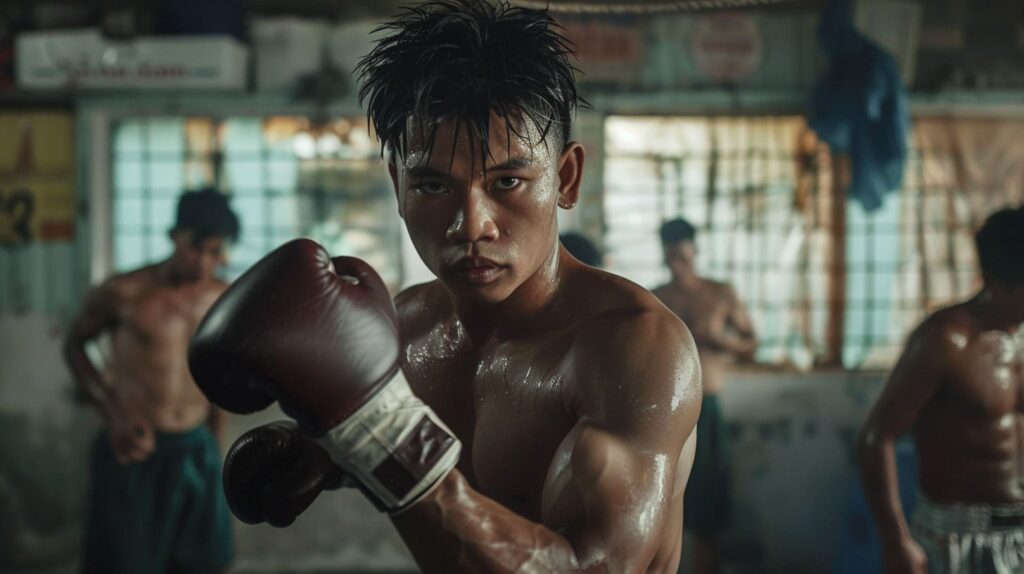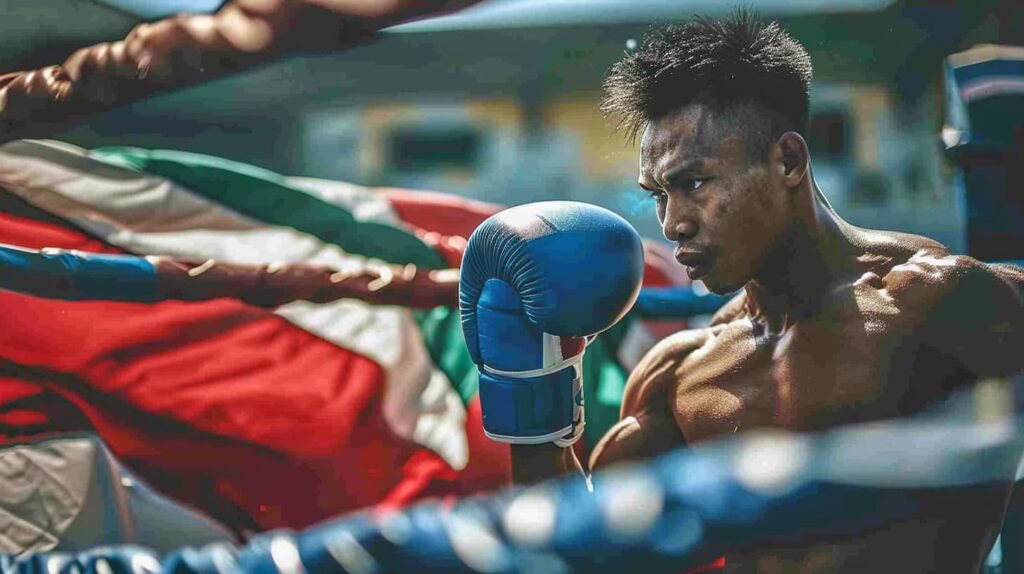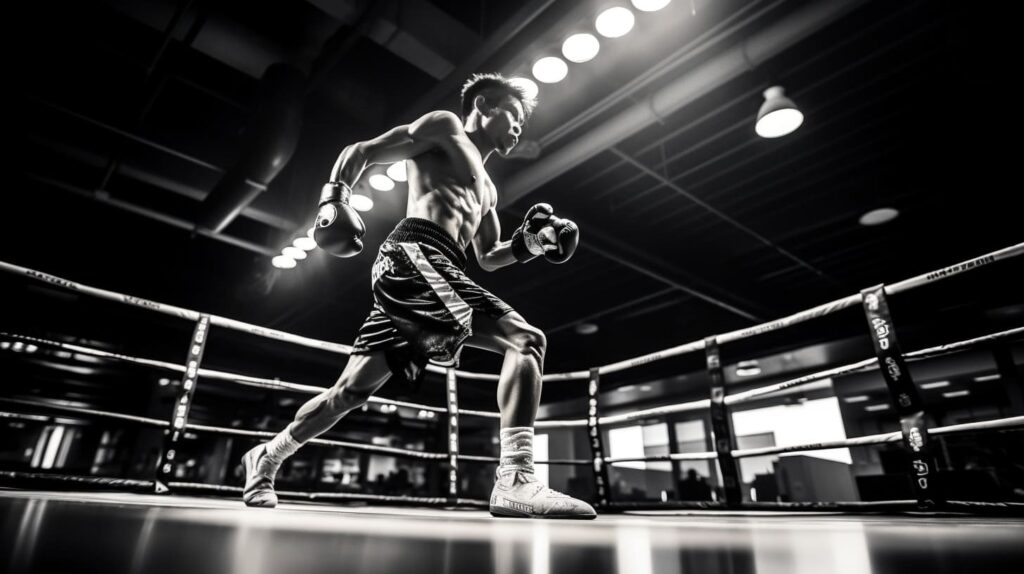Picture this: A martial discipline that draws its energy from the rhythmic movements of agricultural life and the fierce history of blade-wielding fighters. Filipino boxing, a style that’s as much about culture as it is about combat, thrives on a legacy of quick feet and even quicker fists. Let’s unwrap the layers of this compelling fighting form.
The Essence of Filipino Boxing
Take a step back to the early 20th century, where the collision of Western boxing and Filipino martial arts ignited the flame of Filipino boxing. It was a time when this hybrid style began to crystallize, blending the punch-driven focus of boxing with the fluidity and resourcefulness of local fighting arts.
Influences that Shaped Filipino Boxing:
- Western Exposure: Contact with the West introduced the gloves and the ring, but the heart of Filipino martial arts kept beating strong.
- Agricultural Roots: The use of machetes and farming tools in daily life transferred seamlessly into powerful, slicing moves in combat.
Imagine the life of a farmer: the strength and control needed to wield a blade carried over into explosive fighting techniques. This rich backdrop is where Filipino boxing found its edge—quite literally.
Distinct Character of Filipino Boxing Techniques
Filipino boxing isn’t just about throwing punches; it’s about how you throw them. There’s a distinctive emphasis on the upper limbs, converting them into whips that lash out with devastating effects.
Hallmarks of Filipino Boxing Techniques:
- Whip-like Power: Strikes aren’t just thrown; they’re cracked forward with the smooth acceleration of a bullwhip.
- Bolo Punch: More than just a hard hit, it’s a swooping motion reminiscent of swinging a bolo knife in the fields.
This style encourages fighters to stay close, within an arm’s reach, where these whip-like strikes hit hardest. It’s raw, it’s beautiful, and it’s unforgiving.
Manny Pacquiao and His Boxing Strategy

Step into the ring with Manny Pacquiao, a boxer synonymous with lightning-fast jabs and an aggressive style that’s overwhelmed countless opponents. His strategy? A harmonious blend of speed, power, and unrelenting forward pressure.
Pacquiao’s Fight Breakdown:
- Multi-Class Mastery: An exceptional ability to dominate across different weight classes, each move calculated to exploit openings.
- Rapid-Fire Combinations: It’s like his fists have a mind of their own, unravelling opponents with a barrage of punches.
Pacquiao harnesses a strategy that’s fluid, irrespective of the category he’s fighting in. This adaptability, this mastery over the versatile and unyielding nature of Filipino boxing, is what makes him not just a boxer, but a legend.
Filipino Boxing Champions and Their Legacy
Diving into the heart of Filipino boxing, we honor the legends who have lifted the sport to its celebrated status. From the gritty arenas of the past to the shining international stages of today, Filipino champions have consistently demonstrated unparalleled skill and tenacity. These trailblazers have not only conquered boxing rings around the world but also left an indelible mark on the art of pugilism.
Pivotal Champions and their Lasting Impact:
- Ceferino Garcia: Developer of the iconic bolo punch, a testament to the creativity and cultural integration inherent in Filipino boxing.
- Pancho Villa: Famed for his ferocity, he paved the way as the first Filipino world flyweight champion, instilling pride and inspiring future generations.
- Manny Pacquiao: The embodiment of versatility, with an impressive record across multiple weight divisions that showcases the dynamic potential of Filipino boxing.
These champions are far more than their titles; they’re symbols of a nation’s strength and the fire that drives every Filipino boxer training today.
Training Methods and Drills in the Philippines

Let’s lace up the gloves and step inside a Filipino boxing gym, where the unique blend of speed and power is forged through rigorous training. Here, the scent of hard work is as palpable as the buzz of anticipation for the next round.
Core Aspects of Filipino Boxing Training:
- Conditioning Drills: A regimen focused not just on strength, but on agility, formulating the balanced athleticism needed in Filipino boxing.
- Skill Workouts: A mix of technique honing and situational sparring that ensure boxers are calm under pressure and quick on their feet.
Sessions in Filipino boxing gyms are grueling, yet they’re steeped in a tradition that celebrates not only physical prowess but the sheer will to keep pushing beyond limits.
Modern Filipino Boxers and Their Impact

Today’s Filipino boxing scene shines brightly, thanks in part to the exceptional fighters who carry the legacy forward. These contemporary champions bear the torch, melding timeless techniques with new-age innovations.
Contemporary Icons and their Styles:
- Nonito Donaire: Revered for his knockout power and surgical precision, a living testament to the versatility of Filipino boxing.
- Flash Elorde: A nickname earned by sheer quickness, Elorde’s approach to boxing mirrors the rapid, flowing nature of this martial discipline.
The current crop of fighters stands on the shoulders of giants, and their global impact secures Filipino boxing’s place as not just a sport, but as a poignant chapter in the ongoing story of martial arts.
The Footwork and Stance of Filipino Boxing

Filipino boxing, with its dance-like footwork and adaptable stances, offers fighters a tactical advantage that is as striking as it is strategic. Whether adopting the orthodox or southpaw stance, Filipino boxers maneuver with a deftness that complements their rapid striking, creating a fluid symphony of movement and aggression.
Analyzing the Tactical Approach: Southpaw vs Orthodox
In the Filipino boxing arena, the stance is more than just a starting position; it’s an integral part of the fighter’s strategic foundation. Deciding between a southpaw or an orthodox stance sets the stage for the match-up, influencing everything from defensive tactics to the angle and delivery of strikes.
Stance Considerations and Benefits:
- Orthodox Stance: Ideal for those with a strong right hand, offering a steady approach with solid reach and protective balance.
- Southpaw Stance: A left-hander’s haven, creating unexpected angles and opportunities for disrupting an opponent’s rhythm.
Boxers weave these stances into intricate footwork, using movements that have been honed to navigate, advance, and retreat within the battleground that is the ring.
Panantukan Martial Arts: The Ancestral Tie
Panantukan—or Filipino ‘dirty’ boxing—imbues Filipino boxing with its distinctive edge, tracing its lineage back to the ancient warrior culture of Kali Eskrima. In the world of Filipino boxing, these roots are not just respected; they form the backbone of training, infusing empty-hand techniques with the precision and lethal intent of armed combat.
Kali Eskrima’s Influence on Empty-Hand Combat
Emerging from the Filipino Martial Arts (FMA) landscape, Panantukan exemplifies the seamless transition from weapon-based to empty-hand techniques.
Key Aspects of Panantukan’s Influence:
- Weaponry Replication: The hand movements in Filipino boxing echo the arcs and thrusts of traditional weapons, emphasizing direct strikes and fluidity.
- Combative Mindset: FMA drills instill a strategic lens for combat, combining offense and defense for supreme tactical control.
Steeped in centuries-old warrior traditions, Panantukan doesn’t just add depth to Filipino boxing; it merges its historical past with its current resilience.
Philippine Boxing: A Cultural Phenomenon
Boxing is far more than a sport in the Philippines; it’s a cultural embodiment of the grit, endurance, and collective heartbeat of the people. Through feats within the ring, Filipino boxers reflect the resilience and spirit of an entire nation.
Boxing as a Reflection of Filipino Resilience and Pride
Each punch and counter tells a story, a narrative of survival, ambition, and the collective Filipino dream. Boxing matches, often communal events, are manifestations of the nation’s heart, showcasing the perseverance and mettle intrinsic to the Filipino identity.
Boxing’s Influence on Filipino Society:
- A Unifying Force: Through shared triumphs and defeats, boxing has the power to unify people across diverse backgrounds.
- Symbol of Hope: In promoting local heroes, boxing becomes a beacon of aspiration for the youth, highlighting the possibility of rising above circumstances through discipline and dedication.
Filipino boxing isn’t just a display of physical prowess but a testament to the enduring spirit that fuels the archipelago’s vibrant culture.
Defensive Skills and Speed in Filipino Boxing
In the swift dance of Filipino boxing, a boxer’s defense isn’t just about avoiding hits—it’s an integral part of their offense. Fighters are known for making their opponents miss by a hair’s breadth, only to immediately counter with blurring speed. Let’s dive into how Filipino boxers weave together a tapestry of elusive moves and quick counterattacks.
Employing Tactics for Impenetrable Defense and Rapid Strikes
The beauty of Filipino boxing defense lies in its economy of motion. Boxers master the art of using minimal movement to evade attacks, conserving energy and setting themselves up for potent comebacks.
Key Defensive Strategies:
- Slip and Counter: Moving the head just enough to let a punch whiz by, followed swiftly by a counter-strike.
- Bob and Weave: Ducking and shifting from side to side, creating a moving target that’s hard to pin down.
The speed of these maneuvers is pivotal, making it possible for Filipino boxers to rapidly switch between defense and offense, often landing blows before their opponents can reset their guard.
Philippines National Boxing Team Achievements
The Philippines National Boxing Team, also known as ‘The Mighty Punchers,’ are a force to be reckoned with, having garnered accolades that resonate on the global stage. Their tenacity and skill have brought home not just medals but have also raised the profile of Filipino boxing talents worldwide.
A Snapshot of Accolades:
- Olympic Success: A storied track record in the Olympics, securing medals that shine on the international front.
- World Championships: Consistent performances that place Filipino boxers among the world’s best.
These accomplishments speak to the heart of Filipino boxing, epitomizing the dedication and prowess of the athletes who represent their country with pride and determination.
Role of Speed and Defensive Strategies in Filipino Boxing
The heart-pounding speed found within the ranks of Filipino boxing serves as more than just an impressive show—it’s a calculated element of survival in the ring. Combining swift reflexes with intentional defensive moves turns Filipino boxers into veritable champions of evasion and control.
The Importance of Quick Reflexes and Preventive Maneuvers
A relentless training focus on speed develops reflexes that can make the difference between victory and defeat. Boxers anticipate and react in the blink of an eye, dodging incoming attacks and immediately changing tact to seize the offensive.
Elements of Speed and Defense:
- Anticipation Skills: Reading the opponent’s movements to predict and circumvent strikes.
- Quick-Footed Evades: High-speed footwork that allows for nimble repositioning and advantageous striking angles.
Speed and defense go hand in hand, enabling Filipino boxers to effortlessly navigate the ebb and flow of combat with grace and precision.
Famous Filipino Boxing Matches
The story of Filipino boxing isn’t complete without recounting the bouts that have captured the hearts of millions. These historic matches are etched into the annals of boxing not just for their athletic display but also for the palpable human drama they encompassed.
Reliving Historic Battles: The Matches That Captivated the World
Epic face-offs on global stages have turned fighters into national icons and their bouts into legendary tales. Each match was a showcase of pure will, technical skill, and the unyielding resilience emblematic of the Filipino fighting spirit.
Memorable Showdowns:
- Pacquiao vs Barrera: A defining moment that announced Pacquiao’s arrival as a global powerhouse.
- Donaire vs Montiel: A clash that highlighted Donaire’s devastating knockout power and tactical acumen.
These renowned duels are not just wins and losses in record books; they are sources of inspiration, exemplifying the warrior ethos that defines Filipino boxing.
Conclusion
Filipino boxing stands out as a masterful blend of speed, skill, and heart. With its distinctive techniques, remarkable defense, and swift striking strategy, it captivates both boxers and spectators alike. As we reflect on its historic matches, standout champions, and cultural significance, we come away with a profound respect for this formidable art form. It is this relentless spirit coupled with the honed tactics that will continue to propel Filipino boxing onto the world stage, as an indomitable testament to the human spirit and the pride of a nation.
Additional Resources
Diving deeper into the world of Filipino boxing can be both exhilarating and educational. Whether you’re a budding boxer or a seasoned fan, these carefully selected resources will provide further insight into the strategies, history, and techniques that make Filipino boxing a captivating study.
Books
- “Filipino Martial Culture” by Mark V. Wiley
- A comprehensive look into the Filipino martial arts, Wiley’s work provides context and depth to the elements that heavily influence Filipino boxing. It’s perfect for understanding the cultural significance behind the sport.
- Find it on Amazon
- “PacMan: Behind the Scenes with Manny Pacquiao” by Gary Andrew Poole
- This biography gives readers an intimate look at Manny Pacquiao’s life, both in and out of the ring, offering insights into the dedication and strategy of a world-class athlete.
- Get it on Amazon
Documentaries and Films
- “Kid Kulafu” (2015)
- This biographical drama charts the rise of Manny Pacquiao from his humble beginnings to becoming a global boxing icon.
- Watch the Trailer
Educational Websites
- ExpertBoxing
- A treasure trove of tips and techniques for boxers of all levels. While not exclusively focused on Filipino boxing, it provides solid foundational knowledge that’s applicable to the sport.
- Go to Website
- Black Belt Wiki – Filipino Martial Arts
- This wiki offers a well-organized breakdown of Filipino martial arts, encompassing history, techniques, and terminology, all of which enrich the Filipino boxing experience.
- Visit the Wiki
YouTube Channels
- fightTIPS
- With videos featuring techniques, drills, and tips, fightTIPS is a dynamic channel that occasionally covers aspects of Filipino martial arts and boxing.
- Subscribe to fightTIPS
These resources will not only provide a solid foundation in Filipino boxing but also inspire with stories of the greats who have made this style their own. Whether it’s through reading, watching, or practicing, there’s a wealth of knowledge out there to help you on your journey into the fascinating world of Filipino boxing.

